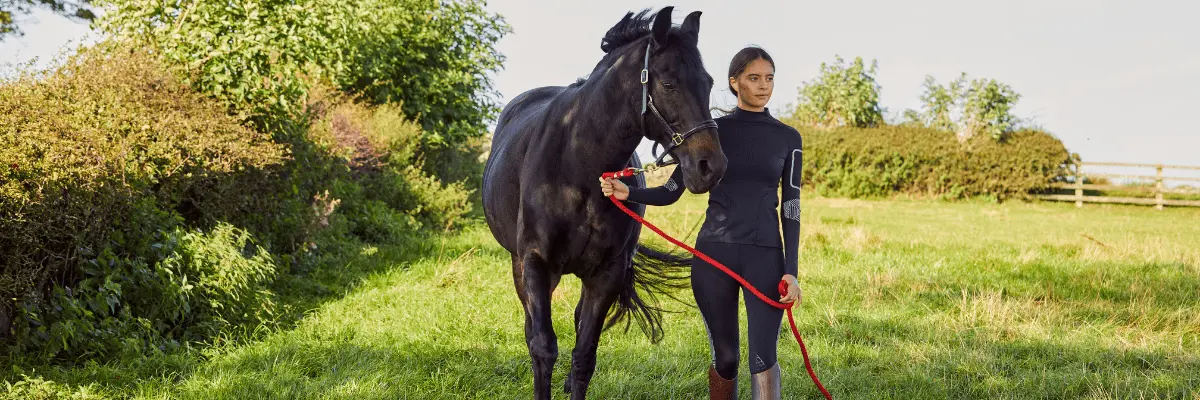
When we heard from Harry Hall One Club Member Kaylie Perring earlier this year, her Kissing Spine rehab story was too interesting to bypass, to anyone starting out on this journey or wondering what’s involved you’ll sure find this blog interesting. From negative Nelly’s to positive Polly’s and gadget Garry’s there are a lot of handy tips to keep you on track.
Will my horse need surgery if they have kissing spines?
When my show jumper Fonz had his Kissing Spines surgery my overall goal was to have a happy horse I could hack. My ideal would have been to jump him around a one-metre track. It is a good idea to set numerous mini-goals along the way – get them going forward, more relaxed, lifting his back from improved core strength. I achieved all this by softening Fonz in walk, then trot and constantly reminding myself that consistency is king, it will take time and Rome wasn’t built in a day.
Kissing Spine rehab will be an emotional rollercoaster with one step forward followed by five steps back. Here are some top tips to remember before you start your Kissing Spine rehab journey:
- Surround yourself with the best team, who are routing for you, supporting you and who listen, help, explore options and create solutions
- You need to remove “negative Nelly’s” and surround yourself with “positive Polly’s”
- There are times that you will feel defeated and deflated, you need your team to hold your hand and remind you it’s a journey
- Celebrate every step in the right direction
- Remember your horse will be more sensitive to pain
- Don’t set crazy goals, you won’t achieve them, and it will lead you to become upset and disappointed. Instead set small achievable goals for each session ahead.
How to treat kissing spines
The golden rules of Kissing Spines Rehab:
- Do something, achieve it, consolidate it and move on
- Create solid foundations
- Horses respond well to things they do regularly not occasionally, so make the changes consistent and they will become habit
- Keep your goal in mind as it will keep you motivated when things are going off track or when life is throwing curveballs your way
- When asking the horse to do something new/go in a different way, build their confidence and praise every effort
- Make them feel like a king. Go back to the foundations to build confidence. Remember it’s like someone trying to learn a new language (I try to always remember this as it helps me remain patient).
Patience, patience, patience:
Kissing Spine rehab takes time. Fact. Don’t be a gadget Garry or take shortcuts. You want solid foundations and good correct muscle development.
Stretch the horse, pay attention to what you’re feeling and notice any behaviour changes. If they are stiffer one way think about how it will impact on ridden work and what exercises you can do to overcome it. Can they stretch further back on one side, can they hold it longer, do they snatch a leg back? Make a mental note of everything. They will likely be more sensitive to pain so bear this in mind when you're teaching them new exercises.
And box rest isn’t always right. Fonz wouldn’t have dealt well with box rest, so I amended it. Hand grazing and creating an outside stable - the same size as his stable but in the paddock with lots of grass and 6ft high electric tape and with an old sensible horse next to him.
How your own riding fitness can help with Kissing Spines rehab:
Take responsibility for your own fitness and self-awareness in the saddle. Learn to know how your riding impacts on your horse. For example, I know that I am stiff and that one leg is stronger than the other. I go to the gym once a week, try to swim twice a week, do 15 minutes of yoga/stretching in my lunch break and try to see my own Osteopath regularly to help keep me in shape. There’s no point in trying to get your horse moving well, forward and freely if you are misaligned and stiff as a rider.
Kissing spines in horses prognosis
A final word on rehab from Kissing Spines surgery:
Think of small, subtle changes, the sort that could help make a real difference:
- Feed from the floor, this includes hard feed and hay
- Always keep their back warm, quarter sheets on colder mornings and thin rug on at night when it can get chilly, I can’t recommend enough the Protechmasta range for this reason
- Ensure saddlecloths are big enough for the saddle and the saddle is not sat on a seam which could create a sore spot.
If I can do this, anyone can. When it's tough look back and see how far you have come, step by step and bit by bit you get there. Remember the positives you have achieved - don’t look at the top of the mountain, look at the path you’re taking to get there and how far you have come.



